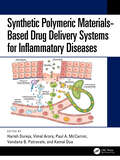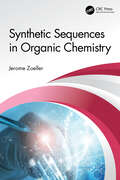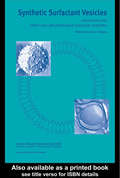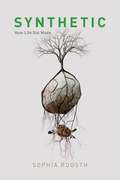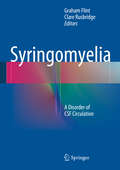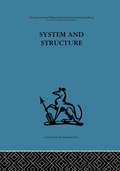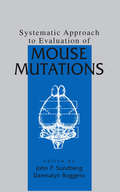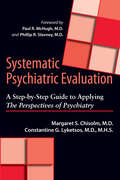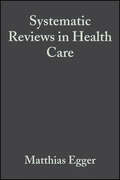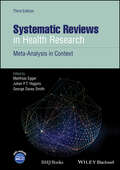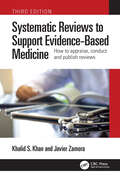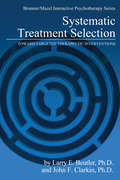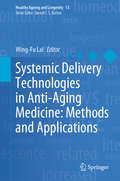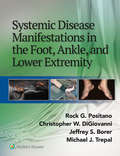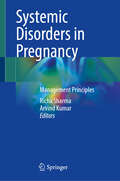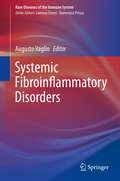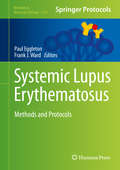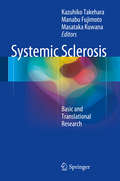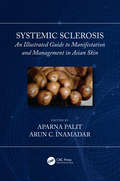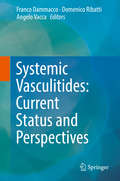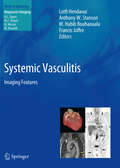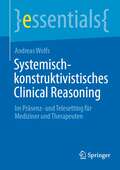- Table View
- List View
Synthetic Peptide Vaccine Models: Design, Synthesis, Purification and Characterization
by Mesut KarahanA new generation of technological vaccines protect against many infectious diseases. This book describes synthetic peptide-based vaccine prototypes – the future of vaccination. Production of peptides becomes simple using automatic synthesizers. Peptides are weak immunogen and need adjuvants to provide an effective autoimmune response, which is why peptide antigens are conjugated with biopolymers and loaded with nanoparticles. The book illustrates the use of peptides vaccine systems and makes predictions of future development not only for infectious diseases, but also for cancers and brain diseases such as Alzheimer, Parkinson and psychiatric diseases. Key Features Summarizes current studies on technological vaccines Describes the uses of vaccines for the prevention of brain diseases Reviews the ways different polymers are used to enhance vaccine efficacy
Synthetic Polymeric Materials-Based Drug Delivery Systems for Inflammatory Diseases
by Vandana B. Patravale Kamal Dua Harish Dureja Vimal Arora Paul A. McCarronThis book provides a comprehensive overview of synthetic polymers and their applications in designing delivery systems for the management of inflammatory diseases. It presents introductory insights into inflammatory conditions, delves into the role of synthetic polymers, and examines diverse delivery approaches. Synthetic Polymeric Materials-Based Drug Delivery Systems for Inflammatory Diseases explores the potential of synthetic polymers in designing drug delivery systems for managing inflammatory diseases, including inflammatory lung diseases, inflammatory bowel diseases, and inflammatory skin diseases, as well as other conditions like cancer, neurodegenerative disorders, rheumatoid arthritis, and eye-related inflammatory conditions. It also discusses the role of synthetic polymers in modulating immune system responses in different disease conditions. Furthermore, it analyzes the 3D printing technologies employed for the preparation of drug delivery systems based on synthetic polymers. Toward the end, the book highlights the challenges and prospects of synthetic polymers in designing delivery systems for the effective management of inflammatory diseases and their clinical usage. This book is intended for researchers and professionals in the fields of pharmaceutical sciences, nanotechnology, and drug delivery systems.Key Features Highlights the role of a synthetic polymer-based drug delivery system against inflammatory responses Explores the cutting-edge technology of 3D printing and its application in preparing drug delivery systems based on synthetic polymers Provides valuable insights into how synthetic polymers can be used to modulate immune system responses Presents regulatory compliance using synthetic polymers in drug delivery systems for inflammatory diseases Examines challenges associated with synthetic polymers in drug delivery systems for inflammatory diseases
Synthetic Sequences in Organic Chemistry
by Jerome ZoellerDrawing on the vast amount of experience the author has gained from working in industrial and university laboratories, this collection of excerpt reports contains essential details from literature relevant to the synthesis of compounds on a milligram to kilogram scale. The excerpts are composed using ChemDraw software and compiled in a Word document. A number of the compounds that have eluded efficient preparation in the past are now presented. Material which will improve any chemist's existing synthetic methodology can be found here. Each of the six chapters, with eighty excerpts, illustrates a novel application of syntheses selected from twenty-first-century literature. Features: This professional text describes many of the classical and contemporary methods of synthesis that have recently found great value in the preparation of needed target compounds in the required quantities. Each example is extracted from a specific literature publication, which the user then would examine for details. This user-friendly professional text provides enormous aid in designing synthetic sequences. Appeals to a broad audience in both academic and industrial laboratories, basically any chemist in need of designing a synthetic sequence or just selecting a single reaction. Author has a vast amount of experience gained from working in academic and industrial laboratories.
Synthetic Surfactant Vesicles: Niosomes and Other Non-Phospholipid Vesicular Systems
by L F UchegbuThe self-assembly of synthetic surfactants and other non-phospholipids into vesicles was first studied in the 1970s by cosmetic scientists when non-ionic surfactant vesicles or niosomes were reported. Since this time a large body of research has sought to define these systems primarily as drug carriers and also as features of interest to the colloid scientist. Synthetic surfactant vesicles, as the name implies, may also be fabricated from a vast array of amphiphiles, including a number of pharmaceutically acceptable materials. They may also be prepared in a variety of shapes and sizes and have a number of applications. This book is designed to serve as an introductory text to the science of non-phospholipid vesicles and will be of use to colloid, drug delivery, cosmetic, and materials scientists. It aims to acquaint the reader with the physicochemistry and biomedical applications of these synthetic surfactant non-phospholipid vesicles. Part one introduces the reader to physicochemical aspects of these synthetic surfactant dispersions and explores the diversity of materials that may be used to formulate vesicles. Part two details methods of vesicle preparation and the application of synthetic surfactant vesicles in a variety of fields ranging from anti-cancer chemotherapy to immunization.
Synthetic: How Life Got Made
by Sophia RoosthIn the final years of the twentieth century, émigrés from engineering and computer science devoted themselves to biology and resolved that if the aim of biology is to understand life, then making life would yield better theories than experimentation. Armed with the latest biotechnology techniques, these scientists treated biological media as elements for design and manufacture: viruses named for computers, bacterial genomes encoding passages from James Joyce, chimeric yeast buckling under the metabolic strain of genes harvested from wormwood, petunias, and microbes from Icelandic thermal pools. In Synthetic: How Life Got Made, cultural anthropologist Sophia Roosth reveals how synthetic biologists make new living things in order to understand better how life works. The first book-length ethnographic study of this discipline, Synthetic documents the social, cultural, rhetorical, economic, and imaginative transformations biology has undergone in the post-genomic age. Roosth traces this new science from its origins at MIT to start-ups, laboratories, conferences, and hackers’ garages across the United States—even to contemporary efforts to resurrect extinct species. Her careful research reveals that rather than opening up a limitless new field, these biologists’ own experimental tactics circularly determine the biological features, theories, and limits they fasten upon. Exploring the life sciences emblematic of our time, Synthetic tells the origin story of the astonishing claim that biological making fosters biological knowing.
Syphilis: A Short Biography
by Andrew P. ZbarSyphilis is an illness with mythology. The story of its origin, dissemination and treatment have all been mired in confusion, a mix of reality and quackery. I have tried to put the organism as the principal protagonist of the story, firmly in an historical focus which centres more on its social impact than on its particular medical management. A diagnosis of Syphilis had personal and community consequence and its impact transcended into the arts. Despite the discovery of an effective treatment to which the organism has fortunately failed to mutate, the restrictions in available management have been social and a result of prejudice towards its victims. This may explain why it is once again on the global rise in places where access to the most basic antibiotics remains limited. This book uniquely considers the sociological sequel of infection, the wider influence extending beyond the physical that has become its legacy.
Syringomyelia
by Graham Flint Clare RusbridgeSyringomelia is a relatively rare clinical entity in which fluid-filled cavities develop within the spinal cord. Although modern imaging technologies usually permit an accurate diagnosis at an early stage, syringomyelia remains an enigmatic condition. This reference monograph provides an up-to-date account of the present state of understanding of syringomyelia and related disorders. The editors aim to document the best clinical practice in diagnosis and treatment and to provide clear guidance on how to reduce the incidence of severe outcomes. New challenges are addressed, including the appropriate management of the increasing number of apparently idiopathic syrinx cavities that are detected. In addition, controversies in current practice and directions for future research are fully discussed. Syringomelia will be an invaluable source of information for experts in the field, specialists in various related disciplines and other interested health care professionals.
System Reengineering in Healthcare: Application for Hospital Emergency Departments (Studies in Systems, Decision and Control #172)
by Salman Ben Zayed Abdullah Bin Gani Mohd Khalit Bin OthmanThis book presents an advanced systematic mapping review (SMR) and state-of-the-art taxonomy of emergency departments (EDs). Focusing on the patients’ level of fulfilment and how it can be enhanced, it examines existing problems like waiting periods and overcrowding and how these can be alleviated to provide a better service. The author examined research papers from 1964 to 2018, and developed six research questions, organising them using mapping studies, the primary objectives of which were firstly, to obtain a common understanding of the problems that need to be highlighted in EDs, and secondly, to re-analyse the methods used. Focusing on quality, the book encourages citations of experimental methods from important studies concerning EDs that can improve services. Through different research papers, various thematic areas in the healthcare sector were examined, like the determination of the relative efficiency of pre-discharge interventions; the analysis of care and managing common indications during the last stages of life; using e-Health to enhance effectiveness and proficiency; the seriousness of patient differences among EDs; the identification of quality problems in healthcare contexts; existing opportunities and the suggested plans. The book concludes that an analytical decision-making process should be used to assess a health technology on the basis of its performance. It stresses the importance of updating this analytical system frequently.
System and Structure: Essays in communication and exchange second edition
by Anthony WildenTavistock Press was established as a co-operative venture between the Tavistock Institute and Routledge & Kegan Paul (RKP) in the 1950s to produce a series of major contributions across the social sciences. This volume is part of a 2001 reissue of a selection of those important works which have since gone out of print, or are difficult to locate. Published by Routledge, 112 volumes in total are being brought together under the name The International Behavioural and Social Sciences Library: Classics from the Tavistock Press. Reproduced here in facsimile, this volume was originally published in 1980 and is available individually. The collection is also available in a number of themed mini-sets of between 5 and 13 volumes, or as a complete collection.
Systematic Approach to Evaluation of Mouse Mutations
by John P. Sundberg Dawnalyn BoggessExperts from The Jackson Laboratory and around the world provide practical advice on everything from how to establish a colony to where to go for specific mutations. The book includes information on medical photography, grafting procedures, and how to map the genes and evaluate the special biological characteristics of mice. It also discusses how to maintain a colony of mice that breed with difficulty, how to approach mapping spontaneous mutations, how to set up systems to evaluate a specific antibody, how to perform simple measurements that yield a large amount of information, and how to access mouse informatics on the Web.
Systematic Psychiatric Evaluation: A Step-by-Step Guide to Applying The Perspectives of Psychiatry
by Margaret S. Chisolm Constantine G. LyketsosTwo Johns Hopkins psychiatrists explain the Perspectives approach to evaluating patients with psychiatric disorders.The Perspectives approach to psychiatry focuses on four aspects of psychiatric practice and research: disease, dimensional, behavior, and lifestory. In Systematic Psychiatric Evaluation, Drs. Margaret S. Chisolm and Constantine G. Lyketsos underscore the benefits of this approach, showing how it improves clinicians' abilities to evaluate, diagnose, and treat patients.Drs. Chisolm and Lyketsos use increasingly complex case histories to help the mental health provider evaluate patients demonstrating symptoms of bipolar disorder, psychosis, suicidal ideation, depression, eating disorders, and cutting, among other conditions. The book also includes an exercise that simulates the Perspectives approach side by side with traditional methods, revealing the advantages of a method that engages not one but four points of view. Featuring a foreword by Drs. Paul R. McHugh and Phillip R. Slavney, the originators of the Perspectives approach, this innovative book will be used in psychiatric training programs as well as by practicing mental health clinicians.
Systematic Reviews in Health Care
by Douglas Altman Matthias Egger George Davey-SmithThe second edition of this best-selling book has been thoroughly revised and expanded to reflect the significant changes and advances made in systematic reviewing. New features include discussion on the rationale, meta-analyses of prognostic and diagnostic studies and software, and the use of systematic reviews in practice.
Systematic Reviews in Health Research: Meta-Analysis in Context
by Matthias Egger George Davey Smith Julian P.T. HigginsSystematic Reviews in Health Research Explore the cutting-edge of systematic reviews in healthcare In this Third Edition of the classic Systematic Reviews textbook, now titled Systematic Reviews in Health Research, a team of distinguished researchers deliver a comprehensive and authoritative guide to the rapidly evolving area of systematic reviews and meta-analysis. The book demonstrates why systematic reviews—when conducted properly—provide the highest quality evidence on clinical and public health interventions and shows how they contribute to inference in many other contexts. The new edition reflects the broad role of systematic reviews, including: Twelve new chapters, covering additional study designs, methods and software, for example, on genetic association studies, prediction models, prevalence studies, network and dose-response meta-analysis Thorough update of 15 chapters focusing on systematic reviews of interventions Access to a companion website offering supplementary materials and practical exercises (www.systematic-reviews3.org) A key text for health researchers, Systematic Reviews in Health Research is also an indispensable resource for practitioners, students, and instructors in the health sciences needing to understand research synthesis.
Systematic Reviews to Support Evidence-Based Medicine: How to appraise, conduct and publish reviews
by Javier Zamora Khalid Saeed KhanAuthoritative, clear and concise, this highly acclaimed book continues to be an essential text for all medical, surgical and allied health professionals who are seeking a quick and respected guide to systematically reviewing the literature. The third edition features a new chapter on 'Publishing systematic reviews’ and numerous new case studies covering the latest developments in the field, including umbrella reviews, reviews of test accuracy, qualitative evidence and prognostic studies, and practice guidelines. The highly experienced authors, who have each contributed to numerous systematic reviews that have helped form policy and practice, ensure that this practical text, which avoids technical jargon, continues to be the reference of choice for all health professionals undertaking literature reviews, including those specializing in epidemiology and public health.
Systematic Treatment Selection: Toward Targeted Therapeutic Interventions
by Larry E. Beutler John F. ClarkinFirst published in 1990. Routledge is an imprint of Taylor & Francis, an informa company.
Systemic Delivery Technologies in Anti-Aging Medicine: Methods and Applications (Healthy Ageing and Longevity #13)
by Wing-Fu LaiThis book presents a multidisciplinary assessment of the state of science in the use of systemic delivery technologies to deliver anti-aging therapeutics now under development. There is a gap between basic aging research and the development of intervention technologies. This major obstacle must be overcome before biogerontological interventions can be put into clinical practice. As biogerontology comes to understand aging as a systemic degenerative process, it is clear that there is a pressing need for technologies that enable cells and tissues in a fully developed adult body to be manipulated systemically to combat aging. The authors review advances in the chemistry and engineering of systemic delivery methods and analyze the strengths and limitations of each.The book is organized into six sections. The first offers an overview of the need for systemic delivery technologies alongside the development of anti-aging therapies and describes approaches that will be required for studying the properties and efficiency of carriers for systemic delivery. Sections II, III and IV describe recent advances in a range of strategies that may enable systemic delivery to help combat aging conditions ranging from cell senescence to decline in immune function and hormonal secretion. Section V discusses practical strategies to engineer and optimize the performance of delivery technologies for applications in systemic delivery, along with their working principles. The final section discusses technical and biological barriers that must be overcome as systemic delivery technologies move from research laboratory to clinical applications aimed at tackling aging and age-associated diseases.Benefiting scholars, students and a broader audience of interested readers, the book includes helpful glossary sections in each chapter, as well as sidebars that highlight important notes, and questions for future research.
Systemic Disease Manifestations in the Foot, Ankle, and Lower Extremity
by Rock G. Positano Christopher DiGiovanni Jeffrey Borer Michael TrepalRecognize when lower extremity disorders signal a larger problem. Systemic Disease Manifestations in the Foot, Ankle, and Lower Extremity is the first clinical reference focused on helping you recognize when lower extremity symptoms indicate the presence of cardiovascular, neurologic, dermatologic, musculoskeletal, endocrinologic, infectious, or other systemic disorders. An impressive roster of multidisciplinary experts guides you through what to look for and how to confirm your diagnostic suspicions. The result is an indispensible resource that can facilitate early detection and timely treatment.
Systemic Disorders in Pregnancy: Management Principles
by Arvind Kumar Richa SharmaSystemic disorders in pregnancy is challenging in terms of diagnosis and management, as it compromises both mother and the baby. This book describes various maternal disorders along with their management algorithms and deals with exact standard operating procedures. It also includes periconceptional management, differential diagnosis, prevention, and latest guidelines and recommendations regarding medical disorders during pregnancy. This book provides helpful information to practicing obstetricians involved in the management of such patients and serves as a reference guide to students and residents in obstetrics and gynecology.
Systemic Fibroinflammatory Disorders
by Augusto VaglioThis book provides detailed information on the nosology, pathology, pathogenesis, clinical presentation, diagnosis and treatment of fibro-inflammatory disorders, rare diseases that often display systemic organ involvement. Among the conditions considered are IgG4-related disease, sclerosing cholangitis, Hashimoto's and Riedel's thyroiditis, retroperitoneal fibrosis/chronic periaortitis, mediastinal fibrosis, Erdheim-Chester disease, gadolinium-induced fibrosis, and sclerosing mesenteritis. This group of entities is still poorly defined and is characterized by the common denominator of chronic inflammatory infiltrate admixed with abundant fibrosis. IgG4-related disease is the prototypical example. Systemic Fibroinflammatory Disorders is the first book to draw together information on these conditions. As these diseases often require an interdisciplinary approach, the book is addressed to specialists of different disciplines, especially internists, rheumatologists, nephrologists, clinical immunologists, and hematologists.
Systemic Lupus Erythematosus
by Paul Eggleton Frank J. Ward"Systemic Lupus Erythematosus: Methods and Protocols" describe a number of genetic, biochemical and immunological techniques. These techniques provide an advancing understanding of the pathology, breakdown of the immune system and therapeutic challenges of SLE in both humans and animal models. Written in the highly successful "Methods in Molecular Biology" series format, chapters include introductions to their respective topics, lists of the necessary materials and reagents, step-by-step, readily reproducible laboratory protocols and key tips on troubleshooting and avoiding known pitfalls. Authoritative and practical, "Systemic Lupus Erythematosus: Methods and Protocols" appeal to biomedical and clinical scientists in a number of pathology disciplines at the doctoral and post-doctoral level.
Systemic Sclerosis
by Kazuhiko Takehara Manabu Fujimoto Masataka KuwanaThis book provides a comprehensive review of the recent advances in the research of systemic sclerosis (scleroderma). Systemic sclerosis is a complex autoimmune disease characterized by vasculopathy, fibrosis, and immune activation. This disease is also associated with certain susceptibility genes and is affected by epigenetic regulation. Recent studies have revealed a variety of new evidence suggestive of the pathogenesis of the disease. These include endothelial progenitor cells, cytokines and growth factors, and B cells. Studies using animal models have also provided novel insight into the pathomechanisms. In addition to these topics, the book covers clinical research regarding biomarkers and autoantibodies. This volume will benefit all rheumatologists and dermatologists as well as basic scientists, especially immunologists, molecular biologists, and biochemists.
Systemic Sclerosis: An Illustrated Guide to Manifestation and Management in Asian Skin
by Aparna Palit and Arun C. InamadarThis book presents a wide variety of cutaneous features of systemic sclerosis under one cover as cutaneous manifestations are often the first to appear and help in diagnosing this condition early. It has a multidisciplinary approach as systemic sclerosis is a multi-system disorder which comes under the purview of various medical specialties like dermatology, rheumatology and nephrology. Numerous cutaneous features are illustrated with explanatory notes. This book would help the students, teachers and professionals in identification, followed by subsequent treatment and management at an early stage. Key Features Focuses exclusively on systemic sclerosis Includes diagnostic tips Explores systemic sclerosis in dark skinned people Consists of key points at the end of each chapter Discusses diagnostic algorithms and flow charts
Systemic Vasculitides: Current Status and Perspectives
by Domenico Ribatti Franco Dammacco Angelo VaccaIn spite of their relatively low prevalence, systemic vasculitides have been the object of intensive basic and clinical investigations over the last few years. As a consequence, important advancements have been achieved: from updated diagnostic and classification criteria and a more rational nomenclature to the recognition of an expanding spectrum of clinical manifestations and potentially devastating complications; from the recognition of the viral etiology of conditions such as HCV-related cryoglobulinemic vasculitis and HBV-associated polyarteritis nodosa to newly named variable vessel vasculitis exemplified by Beh#65533;et's disease; from single-organ vasculitis such as central nervous system vasculitis to the more recently emerging features of the IgG4-related, immune-mediated diseases that are showing remarkable clinical heterogeneity. In addition, intriguing pathogenetic hypotheses are being reported for certain chronic, relapsing vasculitides that are improving our understanding of their biology and basic pathophysiology. New avenues are being explored that will hopefully allow a deeper comprehension of the relationships between certain virus-driven vasculitides and lymphoproliferation, and possibly lead to the identification of novel biomarkers that may be used to single out patients at an increased risk of relapse. This explosion of knowledge is obviously resulting in state-of-the-art, personalized treatments of systemic vasculitides. This book is a collection of reviews on the major vasculitides, written by scientists and clinicians with a multi-year experience in this field. We hope it will provide the reader with a stimulating container of new advances in scientific knowledge and more rational therapeutic approaches to this fascinating chapter of pathology.
Systemic Vasculitis
by M. Habib Bouhaouala Anthony W. Stanson Lotfi Hendaoui Francis JoffreThe prompt diagnosis of systemic vasculitis is essential as a missed diagnosis can be disastrous. Imaging is of vital importance in achieving a correct diagnosis and in some cases also plays a role in endovascular treatment. In this book, the imaging features of the many different types of vasculitis are clearly demonstrated by means of numerous high-quality illustrations. All relevant imaging modalities are considered, and key distinctive characteristics are highlighted. In addition, each chapter discusses the etiology, epidemiology, pathogenesis, clinical presentation, biology, and treatment of the vasculitis in question. This book is the result of cooperation between expert teams from a range of countries. The wealth of illustrations and informative clinical case studies will prove invaluable for all who may be confronted with these problematic disorders.
Systemisch-konstruktivistisches Clinical Reasoning: Im Präsenz- und Telesetting für Mediziner und Therapeuten (essentials)
by Andreas WolfsSystemisch-konstruktivistisch ausgedeutetes Clinical Reasoning bringt einen Mehrwert für die patientenorientierte Gestaltung von medizinischen, pflegerischen und therapeutischen Interventionen. Es bietet teilhabeorientierte Blickwinkel bei der Analyse von Interventionen als Störungen für die Patient*innen, Beziehungen und Interaktionen der Beteiligten von Behandlungssystemen sowie der Gestaltungen von Lehr- / Lernsituationen. Dabei kann es sowohl im Präsenz- als auch im Telesetting erfolgsversprechend als Grundlage der eigenen Reflexion eingesetzt werden.

